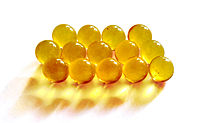
Photo from wikipedia
Fish oil, a common source of omega-3 fatty acids, can be easily oxidized to generate carbonyl species, thus, the measurement of these compounds in fish oil are significant for food… Click to show full abstract
Fish oil, a common source of omega-3 fatty acids, can be easily oxidized to generate carbonyl species, thus, the measurement of these compounds in fish oil are significant for food safety. Here, a comprehensive and sensitive method to quantify forty-four carbonyl species including toxic substances such as acrolein, glyoxal, methylglyoxal and trans-4-hydroxy-2-hexenal in fish oil has been developed and validated. The samples were derivatized with 2,4-dinitrophenylhydrazine, cleaned using C18 solid phase extraction, and analyzed by liquid chromatography coupled with tandem mass spectrometry. The calibration curves represented satisfactory linearity (r2 > 0.998) and the quality control samples showed favorable precisions within an acceptable range (RSD < 10%). The accuracies ranged from 96 to 109%. The detection and quantification limits ranged from 1.5 to 30 ng/mL and 5–90 ng/mL, respectively. The method was successfully applied to determine carbonyl species in ten fish oil products. The proposed method is suitable for high throughput analysis of carbonyl species in fish oil.
Journal Title: Food Control
Year Published: 2017
Link to full text (if available)
Share on Social Media: Sign Up to like & get
recommendations!